Astronomy - Will the Real Albireo Please Stand Up?
A stunning double star, Albireo is also a bit of an enigma. Is it a true binary or the result of a chance alignment? We explore the possibilities.
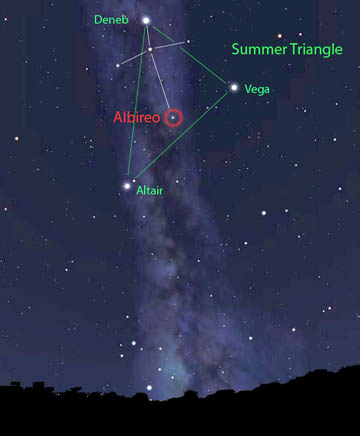
Albireo stands high in the southern sky at the foot of the Northern Cross on late September evenings.
Stellarium
Stellarium
Ask any amateur astronomer what his or her favorite double star is and chances are they'll sing the praises of Albireo. Also known as Beta (β) Cygni, this bright and colorful duo resides at the foot of the Northern Cross, an asterism within the traditional figure of Cygnus, the Swan. Medieval astronomers knew it as the "hen's beak," which well describes its position at the bill-end of the swan.
Whenever I show friends and family Albireo through the scope, they're struck by the vivid color contrast between the brighter, orange primary and sapphire secondary star located 34″ to its northeast. The pair is set in a rich field aglitter with faint stars, which only deepens its appeal.
The stars' hues fit their spectral classifications rather well: Albireo A is an class K3 orange giant 5 times more massive than the Sun, while Albireo B is a hotter, smallerB8 (blue-white) dwarf with a mass of 3.3 solar.
Either way, any telescope or binoculars will split them. For observers in mid-northern latitudes, vibrant Albireo remains a go-to star for anyone wanting a look at one of the sky's finest jewels. Its northern declination keeps it visible most months of the year, though spring through early fall is best.
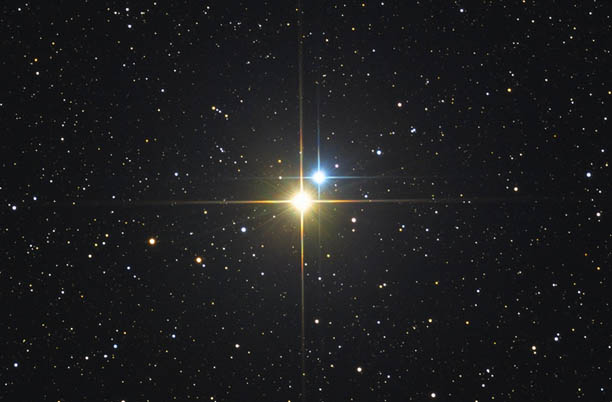
Even a small telescope at low magnification will split Albireo and show its distinctive, contrasting hues. Both stars are located about 380 light-years from Earth.
Stefan Binnewies / Josef Pöpsel / Capella Observatory
Stefan Binnewies / Josef Pöpsel / Capella Observatory
Many of us consider Albireo the quintessential binary star, but do these suns actually orbit about each other, or are we seeing a chance alignment called an optical double? Looking into the literature, we learn that no change in the separation between the two stars has been observed since they were first measured 261 years ago. Nor has the position angle (PA) of the secondary star changed much: 58° to 54°. This slight difference might easily fall within the margin of uncertainty. Albireo's fixed appearance implies an orbital period of at least 75,000 years and probably upward of 100,000 years.
Assuming that's true, we'd have to twiddle our thumbs a long time to measure even a niggling fraction of the secondary's orbital arc. Perhaps there's another way to confirm or deny Albireo's gravitational bond. Both stars occupy the same region of space as they orbit around the galaxy, but their proper motions, that is, the direction each star travels across our line of sight, reveals something very interesting. Instead of coming together, these two appear to be drifting apart.

The entry for Albireo in the Washington Double Star Catalog, maintained by the U.S. Naval Observatory, lists some 14 companions, many of which are field stars. Click to enlarge.
If you go to the double and multiple star bible, theWashington Double Star Catalog (WDS), and scroll down to 19307+2758 (the star's right ascension [R.A.] and declination [Dec.]), you'll see that Albireo appears to have not one but 14 companions in all! Most are line-of-sight pairings and not physically related. The stars labeled D through L appear to be faint, unrelated field stars. No change in position angle or separation has occurred between observations. Only 11th-magnitude Albireo C has shifted a bit in the past 68 years, but it appears the star is leaving Albireo A behind, so is likely unrelated.
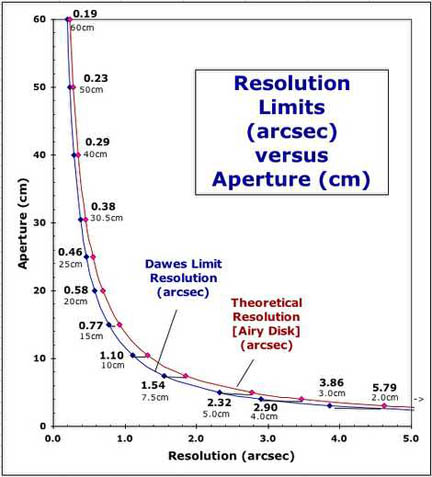
Use this diagram to determine the resolving power of your telescope and the chances of seeing Albireo A's close 5th-magnitude companion. A clean, dust-free 12- or 16-inch scope under ideal conditions might do it.
Andrew James
Andrew James
The others? Albireo Aa (the primary) has two additionalphysical companions named Ab and Ac. Both the Aa-Ab and Aa-Ac pairs were nabbed in the mid-1970s usingspeckle interferometry. At discovery, Ab glimmered just 0.1″ from the primary and Ac at 0.4″. Both are 5th magnitude. There's no way anyone's going to split Ab, since it's currently 0.0″ seconds from A, but there exists a small possibility that 12-inch and larger scopes under superb seeing conditions might wrest Ac from Albireo's dazzle. I've never known anyone who's successfully tackled the challenge. If you're game and succeed, we'd love to hear how you did it.
In 2002, Albireo B, the bright, blue companion of Albireo, was also found to be a physical binary. The Ba-Bb pair is composed of the bright secondary (magnitude 5) with a 9.2-magnitude companion snugged up 0.4″ to its southeast. Given the four magnitude difference between them, this is well nigh impossible to cleave in even large amateur telescopes.
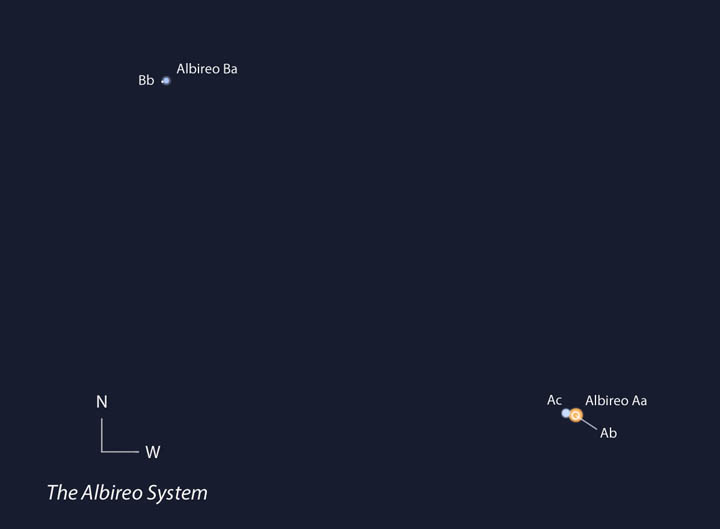
In this greatly enlarged view, we see that the familiar bright Albireo A-B pair is joined by three additional close companions. Separations are 34″ for Aa-Ba, 0.0″ for Aa-Ab, 0.4″ for Aa-Ac, and 0.4″ for Ba-Bb.
Illustration: Bob King, Source: Stellarium
Illustration: Bob King, Source: Stellarium
When you tally up its true companions, Albireo unfolds into a quintuple star! But hold on. There's still the niggling question of whether the familiar gold and blue suns that charm our eyes off are physically connected. To attempt to get an answer, let's take a closer look at the stars' individual proper motions.
According to the the WDS, every year, the right ascension of Albireo A decreases by 2.0 milliarcseconds (mas) and its declination by 1.0 mas, which means it travels to the west-southwest in PA 244°. Meanwhile, Albireo B, with a yearly proper motion of 1.0 mas to the west and 2.0 mas to the south is headed toward PA 206°, a significantly different direction from the primary. A check on their proper motions in the Simbad database gives an even more extreme value for Albireo A of 7.2 mas (decreasing R.A.) and 6.2 mas (south).
That's not all. The radial velocity — the direction toward or away a star is moving from us — is 24 km/sec for Albireo A and 18.8 km/sec for Albireo B. Both are heading in our direction, but at different speeds.
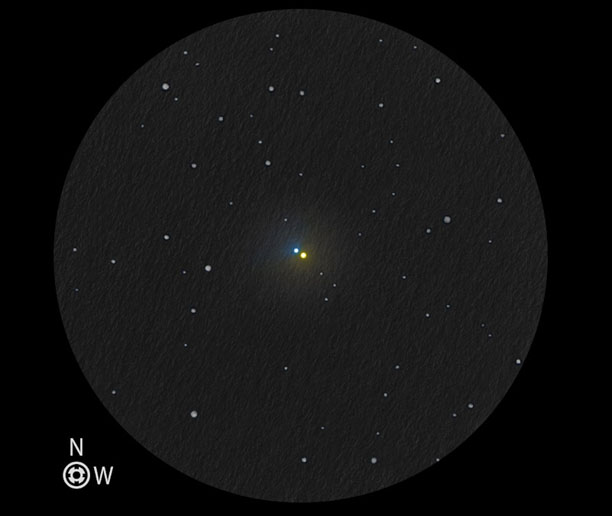
Amateur astronomer Jeremy Perez sketched this excellent likeness of Albireo as seen through the eyepiece. He used an 8-inch telescope.
Jeremy Perez
Jeremy Perez
From all appearances then, the two stars, while relatively near one another and moving through space together, appear to be on separate paths and moving at different velocities, which implies they're unrelated. I don't offer this as absolute proof because measurements can vary, but to date, our favorite double appears to be more like two strangers eyeing one another across the room rather than lovers in binary embrace.
No comments:
Post a Comment